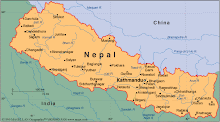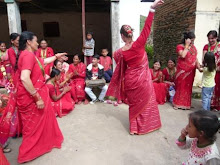








Development: the process of developing or being developed (dictionary.com). Got it???
I think about development every day. It's the work I have landed in. But it's been especially on my mind these days at VSO Nepal's 5 year development strategy is coming to finalization. And as I watch the organizations that I work with really struggle with gaps (of some many kinds) between them and the donors who fund their project.
There aren't any simple solutions...just perhaps less positive and more positive ways of approaching the (huge) challenges involved in the ground realities of "development". Which has something to do with money, power, voice, and (a huge variety) of personal images of what is desirable and "advanced".
In Nepal, in reality, the opportunities for gaps and losses between a) someone who has a vision for what they'd like to see (and money) in the UK (let's say for sake of example), b) the head of a Nepali organization based in Kathmandu, c) a district representative working to implement these two visions (but who is supposed to be empowered and make their own decisions because development these days is people centered) down to the d) field staff who live and see the reality of people's lives in villages in Nepal are, well, many.
In my very limited experience here in Nepal with development, I would say that the misses (and sometimes detrimental effects) within development are just about as many as the positive outcomes.
But I guess that change isn't always a graceful process...anywhere.
Above is a picture narrative of a recent trip to our field area. Which could, perhaps, in some ways serve as a metaphor for my personal experience of current development in Nepal.
(1) There's been monsoon rain, and there are landslides along the road from Kathmandu to Hetauda. This is a particularly large landslide that our jeep tentatively traverses. The roads were totally closed yesterday, and we find out later that after our travel, they are closed again for at least a week due to dangerous conditions. That means no travel between Hetauda and Kathmandu at all, unless you walk or take a plane.
(2) Public transportation. Every once in a while you have to get out of the car (or jeep, or bus) and walk. Until the bus is fixed, or - in this case - the jeep makes it successfully over the landslide.
(3) I'm not sure if the magnitude of the drop comes across in this picture, but this is the ravine that the jeep would slide into had it not made it over the landslide safely. We all clap in excitement when it makes it to the other side.
(4) Our first stop is to a teacher's training program(the program manager and myself). In a situation like this, I've found the best thing I can do is show up, and do absolutely nothing (except be supportive and participate). Nepalis are more capable than leading this training than I am, as they know the language and local context. Having a white face around, I have learned, however, gives an amount of legitimacy to what they are doing and somehow they are taken more seriously. My colleagues are smart people, know this, and invite me to show up at trainings and events and other things whenever they can.
The teachers in the training had a great time learning child-friendly teaching methods. One teacher was so happy at the end of the training that he talked for a good 15 minutes passionately about how these 2 days were more valuable to him than the 7 day training that was provided to him by the government to prepare him for teaching.
As good as the training was (and it really was), it is unlikely that anyone will be able to do any follow up or ongoing learning/support with these teachers. And as 60% are only temporary teachers, it's hard to know where they'll be 6 months from now or what they might - in reality -be able to implement.
Step by step, though...this is a good start, for sure. The 15 minute speech convinces me of that.
(5) Raju and I go to to visit one of our SEC (Supplementary Education Centers) in our project area. They are in remote regions, which is good, because we are wanting to serve children in the truly remote/excluded areas of Nepal. The challenge? Supervision, training, and field visits. Extremely difficult in really remote areas. How do you train and support staff when you can only visit them once every few months and they often can't be reached on mobile phones?
Here's Raju on a bridge as we cross. Apparently he gets mobile phone service here, though.....
(6) A water buffalo is taking refuge in the water. It's a hot day. We see women doing laundry in the 5 streams and rivers that we cross, hand crafted nets to catch fish, and tons of children playing in the water. They are definitely not in school. It's too hot, and there is too much work to be done in the fields at this time of year.
(7) Here's the inside of one of our SEC centers. Notice the women and others from the village at the window who are watching our whole visit. This is the norm. I am so good at not being worried about intense staring any more. The children in our class are either at risk of dropping out of school, or are non-school going children. This means that they are busy working in the fields during the day and can't make it to school (but have committed to coming to our 2 hour-a-day classes.
(8) We decide to get the kids out of the classroom and play some learning games outside. Circles and games and singing and dancing- yep - this is fun. Even though the kids will go right back to chairs and rows and recitation as soon as we leave. Which is okay - because consistency is rewarded in Nepal. And these children need to be successful ultimately within the system of which they are a part.
(9) We take a last photo as we leave - the kids holding up their notebooks. This is for the funder. My Nepali colleagues are ALWAYS taking pictures for the funders. They have been well trained. This is so that the funders can see where their money has gone.



3 comments:
Fascinating, Tiffany. I am just beginning to understand my relationship (funder?) with my school in Kenya. The elaborate presentations of dance, songs and speeches, well documented with camera, is not only their way of showing thanks but proving to the outside world and me that they are using the money consciously. Each school seems to be well versed in this.
Tiffany, This very well reminds me of my life in Nepal and the challenges of develpment work not only in Nepal but almost everywhere. May be as Development practitioners we just have to keep on hoping that situations will always change regardless of time
The Photos are amazing especially the jeep. It reminds me of the road trips from Hetauda to Ktm.
@ Mom - yes, they are well versed. What is nice about your connection with the school in Kenya is that you have a personal connection with the and go and visit. That is rare.
@Elijah- yes! Remember that road/journey?? It's closed these days - too much rain and too many landslides.
Post a Comment